



Underway replenishment (UNREP)
In order to carry out the Navy's mission effectively, fleet units must be capable of remaining at sea for prolonged periods of time, possibly in areas of the world where friendly re-supply ports are not available, and remain fully ready to carry out any assigned tasks. Military Sealift Command (MSC) ships are equipped to replenish combatants underway with fuel, ammunition,
provisions, and spare parts. As a result of underway replenishment techniques, the US Navy can remain mission ready to carry out US policy any where in the world.
The first significant underway replenishment (UNREP) operation at sea was with the collier USS
Marcellus and the Navy warship USS Massachusetts in 1899. Since this first UNREP, many
methods for transferring cargo have been tried. On board the USNS Rappahannock the two major
methods of transferring dry cargo are via VERTREP with a helicopter, and wire highline utilizing a
standard tensioned replenishment alongside method or STREAM rig.
Underway replenishment (UNREP) is a broad term applied to all methods of transferring fuel,
munitions, supplies, and personnel from one ship to another while the vessels are underway. Two
general methods of UNREP are used - connected (CONREP) and vertical (VERTREP). They may
be used singly or at the same time. In connected replenishment, two or more ships steam
side-by-side and the hoses and lines used to transfer fuel, ammunition, supplies, and personnel
connect the ships.
Vertical replenishment is carried out by helicopters with the ships in close proximity, or miles apart depending on the tactical situation and the amount of cargo to be transferred. Connected replenishment involves two processes - refueling and re-supply. In fueling at sea (FAS), fuel is pumped from the delivering ship like the USNS Rappahannock, or a Navy vessel such as a fast combat support ship (AOE). Other replenishment ships such as the combat stores ship (AFS) and
the ammunition ship (AE) can deliver fuel, but their primary mission is the delivery of dry cargo by methods referred to replenishment at sea (RAS).
There are several factors in favor of replenishment with the ships alongside each other instead of astern. First, by replenishing alongside, the oiler or other auxiliary ship, can service two ships at once, with multiple replenishment stations to each ship. Second, by replenishing alongside rather than astern, the whole formation of ships can maintain greater speed (up to 16 knots instead of the 7-8 knot maximum for astern refueling). Third, by replenishing alongside, both fuel and dry cargo can be transferred, instead of being limited to fuel only. Astern fueling does have a place in the replenishment plan, but it is generally limited to a tanker in convoy refueling the convoy escorts.
Underway replenishment techniques continue to advance with the introduction of new systems and
equipment. STREAM stands for Standard Tensioned Replenishment Alongside Method and is
utilized in both RAS and FAS evolutions. The STREAM rig is preferred over other connected
replenishment methods as it permits greater ships separation.
When utilizing the STREAM rig for FAS operations a tensioned spanwire is suspended between
the two ships. A series of hose saddles are attached to the spanwire by trolleys. The actual transfer
hoses are then suspended in between the saddles. The receiving end of the hose rig is tipped with
a coupling. A variety of fueling couplings may be used to ensure compatibility between the delivery
and receiving ships. The most common is a probe fueling coupling. The probe may be used in the
transfer of either DFM or JP-5 products. The probe itself has a latching mechanism that holds it in
the receiver by spring force. The receiver is mounted on the receiving ship by a swivel arm. The
swivel arm allows the receiver to move throughout the full working range of the receiving station,
ensuring proper alignment prevents the probe from unseating. The probe assembly will unseat from
the receiver when a 2,500 lb. line pull is applied. The receiver also has a manual release lever,
which is the desired way to release the probe upon completion of the fuel transfer.
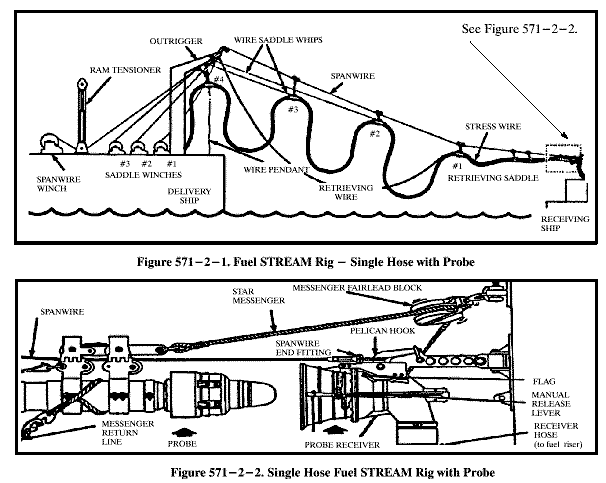
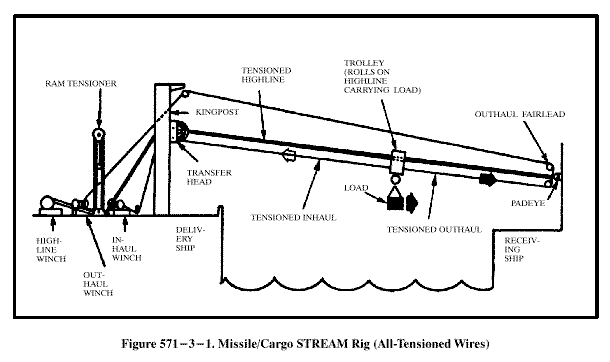 During RAS the STREAM transfer rig utilizes a tensioned wire highline suspended between two
ships. The exact type of STREAM rig is dependent on the kind of cargo. In all rigs, cargo to be
transferred is connected to a trolley, which rides on the highline. The trolley is moved between the
ships by inhaul and outhaul winches located on the delivery ship. When using a STREAM rig with all
tensioned wires, the wire rope outhaul is fairled through a SURF (Standard Underway
Replenishment Fixture) block and attached to the outboard side of the trolley. The SURF is located
on the receiving ship. A ram tensioner, located on the delivery ship, applies highline tension
ensuring constant load support regardless of ship separation or motion. However, if ship
separation becomes too great the amount of wire on the winch drum may be exceeded. A stream
rig can handle loads up to 8,750 lbs. under ideal conditions.
During RAS the STREAM transfer rig utilizes a tensioned wire highline suspended between two
ships. The exact type of STREAM rig is dependent on the kind of cargo. In all rigs, cargo to be
transferred is connected to a trolley, which rides on the highline. The trolley is moved between the
ships by inhaul and outhaul winches located on the delivery ship. When using a STREAM rig with all
tensioned wires, the wire rope outhaul is fairled through a SURF (Standard Underway
Replenishment Fixture) block and attached to the outboard side of the trolley. The SURF is located
on the receiving ship. A ram tensioner, located on the delivery ship, applies highline tension
ensuring constant load support regardless of ship separation or motion. However, if ship
separation becomes too great the amount of wire on the winch drum may be exceeded. A stream
rig can handle loads up to 8,750 lbs. under ideal conditions.
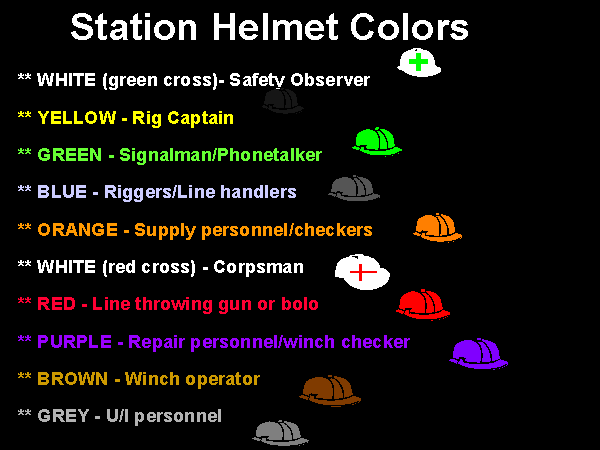 A replenishment at sea consists of two or more ships, one of which will be designated the
"guide" ship. The guide will generally be the ship delivering cargo, but in a two-ship replenishment this may be changed. From the shiphandling aspect, the responsibility of the guide ship is to maintain steady course (by gyro) and speed (by engine). The other ship(s) are referred to as "approach" ship(s), and their job is to come to station alongside the guide and maintain that station throughout the replenishment. The goal of the approach ship is to come alongside the guide, with sending and receiving stations aligned, at a lateral separation of about 160 feet, and then maintain that station throughout the replenishment.
The first step in conducting a replenishment at sea, from the operations and shiphandling
standpoint, is to coordinate a rendezvous time and position. While this is being done, additional
information such as fuel quantities required and fueling stations and fittings available will also be exchanged and coordinated. Selecting a good rendezvous position, with plenty of clear water and acceptable to all ships' operational requirements, often requires some compromise of less urgent requirements in favor of more important considerations. If either ship has other pressing
commitments, the replenishment course and speed (Romeo Corpen) may also be a subject for
discussion during the planning and coordination stages.
Once the receiving (also referred to as "customer" or "approach") ship rendezvous with the delivery (or "guide") ship, the next task, if not already accomplished, is to agree on a Romeo Corpen. Normal speed for auxiliary ship replenishments will be 12-14 knots. Selecting the replenishment course can be more of a challenge, depending on sea state. Replenishments are routinely conducted in sea state 4, with highly skilled personnel on both ships they can successfully be conducted in sea state 5. A rule of thumb is that if the guide ship is able to remain within 1 degree of base course, the replenishment is a definite "go". If the guide is yawing 1.5 degrees, it is a judgment call based on skill and experience, as well as operational necessity. And if the guide is yawing as much as 2 degrees on either side of base course, it's probably not possible to safely conduct a replenishment. Replenishments will normally be conducted on a Romeo Corpen that best satisfies both ships' follow on commitments, but in extreme conditions the sea state will determine the course, and even whether the replenishment is possible. Quartering seas are the worst possible situation from a shiphandling standpoint.
Once a Romeo Corpen is agreed upon and the guide ship is steady on that course and speed, the receiving ship's next task is to come to waiting station. The duty of the guide ship is to
steer the agreed upon course and maintain a constant engine speed. Both ships will have gear
tested and stations manned to at least the same standard used for sea details at arrival and
departure from port. The purpose of waiting station is threefold. First, it improves the efficiency of the operation by having the approach ship begin coming alongside from a fairly close station (shorter approach times, less waiting around on deck). Second, it provides the approach ship an opportunity to accurately gauge the guide ship's course and speed. And last, but not least, it gives everyone on the bridge, including the Master, a chance to acclimate to being at such close proximity to another ship. All shiphandling on the approach ship side is relative to what the guide ship is doing, so matching course and speed is critical. A waiting station of 600 yards astern the guide ship, and just outside the guide ship's wake on the appropriate side, maintains about 100 feet of open water between the approach ship's side and the guide's wake. Ships normally spend at least ten minutes in waiting station, and may spend 30 minutes to an hour if one arrives early.
When the guide ship is ready to receive the customer ship alongside, she'll indicate that by hauling up the Romeo flag on the appropriate side. At that time, or whenever ready, the customer ship will commence her approach alongside the guide. The approach ship indicates the commencement of her "approach" by also hauling up the Romeo flag on the appropriate side.
Replenishment at sea demands the very best of helmsmanship from both the guide and approach ships. As the two ships close each other, the hydrodynamic forces will both change and increase noticeably. At a replenishment speed of 12 knots, a one degree course variation will move the ship 20 feet sideways per minute. The best separation alongside during the replenishment depends on a number of factors, but is controlled by wanting to ensure the safest separation while keeping the probes seated. For surface combatants, 140-160 feet seems to work well. Larger ships seem to favor 160-180 feet. Carriers are especially challenging because of the flight deck overhang, but by the time the separation increases to 200 feet, they are probably at the point of unseating the probes.
A replenishment at sea consists of two or more ships, one of which will be designated the
"guide" ship. The guide will generally be the ship delivering cargo, but in a two-ship replenishment this may be changed. From the shiphandling aspect, the responsibility of the guide ship is to maintain steady course (by gyro) and speed (by engine). The other ship(s) are referred to as "approach" ship(s), and their job is to come to station alongside the guide and maintain that station throughout the replenishment. The goal of the approach ship is to come alongside the guide, with sending and receiving stations aligned, at a lateral separation of about 160 feet, and then maintain that station throughout the replenishment.
The first step in conducting a replenishment at sea, from the operations and shiphandling
standpoint, is to coordinate a rendezvous time and position. While this is being done, additional
information such as fuel quantities required and fueling stations and fittings available will also be exchanged and coordinated. Selecting a good rendezvous position, with plenty of clear water and acceptable to all ships' operational requirements, often requires some compromise of less urgent requirements in favor of more important considerations. If either ship has other pressing
commitments, the replenishment course and speed (Romeo Corpen) may also be a subject for
discussion during the planning and coordination stages.
Once the receiving (also referred to as "customer" or "approach") ship rendezvous with the delivery (or "guide") ship, the next task, if not already accomplished, is to agree on a Romeo Corpen. Normal speed for auxiliary ship replenishments will be 12-14 knots. Selecting the replenishment course can be more of a challenge, depending on sea state. Replenishments are routinely conducted in sea state 4, with highly skilled personnel on both ships they can successfully be conducted in sea state 5. A rule of thumb is that if the guide ship is able to remain within 1 degree of base course, the replenishment is a definite "go". If the guide is yawing 1.5 degrees, it is a judgment call based on skill and experience, as well as operational necessity. And if the guide is yawing as much as 2 degrees on either side of base course, it's probably not possible to safely conduct a replenishment. Replenishments will normally be conducted on a Romeo Corpen that best satisfies both ships' follow on commitments, but in extreme conditions the sea state will determine the course, and even whether the replenishment is possible. Quartering seas are the worst possible situation from a shiphandling standpoint.
Once a Romeo Corpen is agreed upon and the guide ship is steady on that course and speed, the receiving ship's next task is to come to waiting station. The duty of the guide ship is to
steer the agreed upon course and maintain a constant engine speed. Both ships will have gear
tested and stations manned to at least the same standard used for sea details at arrival and
departure from port. The purpose of waiting station is threefold. First, it improves the efficiency of the operation by having the approach ship begin coming alongside from a fairly close station (shorter approach times, less waiting around on deck). Second, it provides the approach ship an opportunity to accurately gauge the guide ship's course and speed. And last, but not least, it gives everyone on the bridge, including the Master, a chance to acclimate to being at such close proximity to another ship. All shiphandling on the approach ship side is relative to what the guide ship is doing, so matching course and speed is critical. A waiting station of 600 yards astern the guide ship, and just outside the guide ship's wake on the appropriate side, maintains about 100 feet of open water between the approach ship's side and the guide's wake. Ships normally spend at least ten minutes in waiting station, and may spend 30 minutes to an hour if one arrives early.
When the guide ship is ready to receive the customer ship alongside, she'll indicate that by hauling up the Romeo flag on the appropriate side. At that time, or whenever ready, the customer ship will commence her approach alongside the guide. The approach ship indicates the commencement of her "approach" by also hauling up the Romeo flag on the appropriate side.
Replenishment at sea demands the very best of helmsmanship from both the guide and approach ships. As the two ships close each other, the hydrodynamic forces will both change and increase noticeably. At a replenishment speed of 12 knots, a one degree course variation will move the ship 20 feet sideways per minute. The best separation alongside during the replenishment depends on a number of factors, but is controlled by wanting to ensure the safest separation while keeping the probes seated. For surface combatants, 140-160 feet seems to work well. Larger ships seem to favor 160-180 feet. Carriers are especially challenging because of the flight deck overhang, but by the time the separation increases to 200 feet, they are probably at the point of unseating the probes.
To commence the approach and begin closing the guide, all that's required of the approach ship is to increase engine speed by 4-5 knots. On Rappahannock, we would normally use about 60%
throttle for 13 knots, so from waiting station we will increase speed to 80-85% (17-18 kts engine
speed) to commence the approach. While closing the distance to the guide ship, the lateral
separation between ships deserves some attention. However, if the approach ship has
established good waiting station, it's likely that nothing more than minor course corrections will be required until alongside.
When about 1 ship length astern of the guide, the approach ship can reduce speed to 1-2 knots above base speed. From this point until alongside and settled in position, matching speed will be the conning officer's primary concern. It's worth noting that an UNREP approach is significantly different from a docking maneuver. Mental adjustments to appropriate relative motions, lateral separation, and vessel aspect must be applied. To put it simply, what looks "right" during a docking maneuver is very different from what looks "right" during an UNREP approach.
As the approach ship's bow crosses the guide ship's stern, but probably not before then, the approach ship can ring up an engine order to match base speed. Before reducing to base speed
the conning officer should ensure that he has enough momentum to pass through the pressure wave
generated by the guide ship and carry herself into station. At times, the conning officer will match base speed too early and end up stalled out on the guide ship's pressure wave, which can result in a prolonged delay in getting alongside. From this point forward, engine orders to bring the ship into position and match speed are made almost entirely by eye, keeping in mind the base speed determined while in waiting station. The exact matching speed while alongside the guide will probably be very slightly less than the speed required to match while in waiting station. One very effective technique is to order an engine speed somewhat below the matching speed to reduce excess headway, rather than trying to laboriously "glide" into position. However, in using this technique the peculiarities of the ship and the current sea state must be taken into account.
On a large, relatively low-powered auxiliary ship, perhaps the most challenging aspect of
replenishment conning is finding the matching speed alongside. Occasionally, the conning officer
will basically luck out and hit both proper position and matching speed at the same time. More
commonly, he will have to order an engine speed below matching speed to bleed off excess
headway, then ring up an engine order above matching speed to catch the afterward drift (relative
to the guide ship). It's not unusual to go through several cycles of ordering speeds, alternately, above and below the required final speed to figure out exactly what's required. The goal should be to decrease the range of engine orders until the needed engine setting is determined. One factor that adds to this challenge is the very slow rate of acceleration that most large auxiliaries experience.
As soon as the approach ship reaches adequate position, a shotline is sent for the phone
and distance (P&D) line, which is marked every 20 feet by a flag. Once the P&D line is
across, the job of maintaining separation becomes much easier, since constant "eyeballing" is no
longer required. The P&D line also provides for sound powered bridge-to-bridge communications.
Once alongside, the shotlines for the replenishment stations can be sent over, the messenger
hauled across, with spanwire and hoses following. The team on deck and in the pumproom are
then ready to commence cargo transfer.
Maintaining station alongside is best done through a series of small corrections. Of course, the rougher the conditions, the larger the envelope the ship will be operating in, so course and speed adjustments need to be tailored to the conditions. Ideal station while alongside will generally result in the replenishment rigs being aligned, with a ship-to-ship separation in the 140-180 foot range. At closer separations, the hydrodynamic forces between two large ships begin to build
quite rapidly. At greater separations, the replenishment rigs begins to see larger stresses
(particularly when a probe fitting is used, which can unseat at due to excessive lateral separation).
Upon completion of cargo transfer, the team on deck will begin sending back or retrieving the replenishment rigs. At this time, a prime concern from the shiphandling standpoint is to maintain station and not begin drifting away from the guide. Lines can become fouled, and in any case the added distance will put more spanwire in the water. Once all lines are clear of the other ship, the approach ship can begin opening the guide. This is probably the easiest part of replenishment shiphandling and can be accomplished by ordering a 2-3 degree course change away from the guide and increasing speed 2-3 knots. As those changes begin to take effect, and with the ships a safe distance apart and opening gradually, the process can be repeated as desired while the ships clear each other.
Replenishment at sea involves an extended period of time where two ships are in close proximity while at relatively high speeds. Any problem at all, either external to the ships or internal to one or more of the ships, can require an immediate and timely disengagement. The
Captain of either ship can initiate an emergency breakaway procedures if there is a maneuvering
problem or an unsafe situation is developing. An emergency breakaway follows the same procedures as a normal breakaway, but all steps are expedited as much as possible.
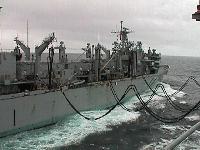

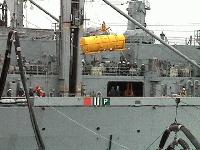
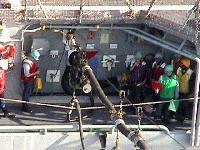

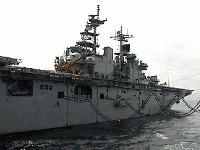
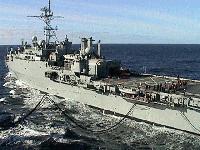
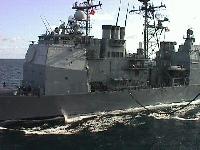
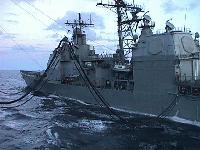

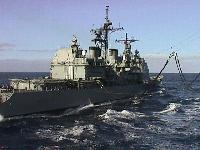

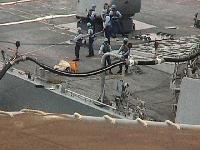
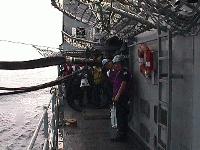



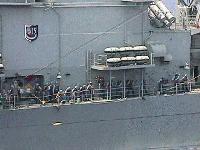
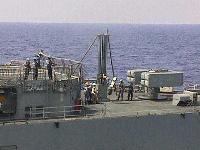
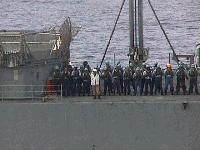
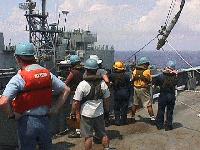
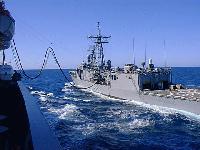
Sources and Resources
http://www.fas.org/man/dod-101/sys/ship/unrep.htm
Maintained by Robert Sherman
Originally created by John Pike
Updated Saturday, March 06, 1999 12:25:38 PM






























